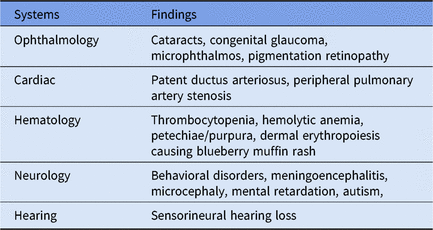To the Editor— Congenital rubella syndrome (CRS) is seen more commonly in developing countries due to the lack of rubella vaccine as a part of their national immunization programs, thus leading to the continued disease burden in this part of the world. CRS incidence had considerably decreased in the United States since the introduction of rubella vaccine in 1969 and was considered eliminated from the United States in 2004, although occasional cases (no native cases, however) have been reported in literature since then.Reference Al Hamoud, Murphy and Perez 1 Given the increased travel into those developing countries, increasing immigration of susceptible population (unimmunized due to lack of resources) to the United States, and decreasing vaccination rates in the United States (unimmunized due to exemptions), the incidence of rubella may be on the rise.Reference Shukla and Maraqa 2 Physicians, especially of the younger generation, may have rarely seen a case of congenital rubella syndrome due to previous effective successful immunization program. Furthermore, CRS identification can be challenging because initial symptoms may be consistent with other congenital infections, as well and findings of sensorineural hearing loss or developmental delay may be identified only later in life.
We discuss here a case highlighting 3 important points: (1) CRS should still be on the differential of congenital infections work up in developed countries; (2) early recognition for CRS patients assists in early intervention and can have profound impacts on neurodevelopmental outcomes; and (3) CRS could have significant infection control implications postdiagnosis, and appropriate isolation precautions need to be followed to limit the spread of the virus.
A late preterm infant was born to a 27-year-old mother who had recently immigrated from Afghanistan. On initial exam, the infant was noted to have a grade 4/6 systolic heart murmur and “blueberry muffin lesions” on her face and trunk, which faded quickly after birth. She had bilateral cataracts (later requiring repair and lens replacement) and hypotonia. Because of the rash, echocardiogram findings of patent ductus arteriosus, persistent pulmonic stenosis, and thrombocytopenia, congenital rubella were considered in the differential diagnosis. Long-bone X-rays reported “celery stalk metaphysis,” and she failed a hearing test as well. Serology returned positive for rubella IgM, confirmed with polymerase chain reaction (PCR) from cerebrospinal, oral, and urine specimens.
Apparently, the mother had received the live rubella vaccine in preparation for her immigration, early during her pregnancy (ie, unaware of her pregnancy at that time). The mother recalled febrile illness with rash, conjunctival infection about a week prior to the vaccine administration. The infant’s rubella virus genotypic test by public health laboratory identified wild-type virus, indicating that CRS was acquired from the initial maternal viral infection and was not related to the maternal rubella vaccine.
Importantly, CRS, being a multisystem disease, requires a multidisciplinary team approach to improve patient outcomes (Table 1). The treatment of patients with CRS is largely supportive, though it has incredible implications for long-term neurodevelopmental outcomes. The opportunity for early intervention for psychiatric pathology has long-term implications on overall patient outcome.Reference Chauhan, Sen, Jhanda and Grover 3
Table 1. Common Presentations of Congenital Rubella SyndromeReference Kimberlin, Brady, Jackson and Long 4

Obstetricians and pediatricians should be aware of the unique scenario, as mentioned. If the maternal infection is confirmed during pregnancy, the further risk of CRS to fetus needs to be discussed with family. Congenital defects occur in up to 85% of fetuses if maternal infection occurs during first 12 weeks of gestation, 50% if infection occurs during the first 13 to 16 weeks of gestation, and 25% if the infection occurs during the end of second trimester. Additionally, in case of inadvertent rubella vaccine administration during pregnancy or if the pregnancy occurs within 28 days of immunization, the patient should be counseled on the theoretical risks to the fetus although the risk is 0.2%, which is considerably lower than the risk with wild rubella virus.Reference Kimberlin, Brady, Jackson and Long 4
A CRS diagnosis has important implications for infection control, necessitating early identification in the neonatal period. Infants with CRS can continue to shed the virus in urine and nasopharyngeal secretions for up to 1 year. Interestingly, the virus has been reported to be shed for up to 3 years in infants with a high titer from lens aspirate.Reference Menser, Harley, Hertzberg, Dorman and Murphy 5 Contact isolation is indicated for children with proven or suspected congenital rubella until they are at least 1 year of age, unless 2 cultures of clinical specimens (throat swab and urine specimen) obtained 1 month apart after 3 months of age are negative for rubella virus. Hand hygiene cannot be overemphasized in such a situation in reducing transmission from the urine of children with CRS. Given the comorbidities of CRS, these infants will likely need frequent clinic visits to various subspecialists as well, increasing the chances of exposure to relatively susceptible populations. The appropriate isolation precautions can only be instituted if the CRS diagnosis has been considered and confirmed. CRS is a reportable disease, and all cases should be reported through local or state health departments.
Physicians need a low threshold for investigating the possibility of CRS in neonates in a clinically relevant setting, not only for the accurate diagnosis but also for the direction of appropriate supportive care in timely manner due to multisystem morbidities. Appropriate infection control strategies should be ensured in public settings until these patients become noncontagious to limit the spread of the virus in the rest of the susceptible community.
Acknowledgments
We would like to thank the parents of the patient to allow us to publish her case.
Financial support
No financial support was provided relevant to this article.
Conflicts of interest
All authors report no conflicts of interest relevant to this article.



